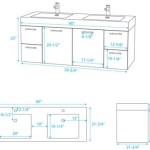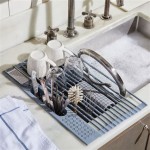Best Built-In Soap Dispenser for Kitchen Sink: A Comprehensive Guide
The modern kitchen is characterized by its efficiency and streamlined design. One element that contributes significantly to this aesthetic and functionality is the built-in soap dispenser. Integrated directly into the countertop or sink, these dispensers offer a convenient and hygienic way to access dish soap or hand soap, eliminating the clutter of bottles around the sink area. Selecting the best built-in soap dispenser for your kitchen sink requires careful consideration of several factors, including material, capacity, pump mechanism, installation requirements, and aesthetic compatibility with your existing fixtures.
This article aims to provide a comprehensive guide to understanding the various aspects of built-in soap dispensers, highlighting key considerations for selecting the optimal model for your needs. We will explore the pros and cons of different materials, delve into the mechanics of pump operation, discuss installation complexities, and address common problems that may arise. By understanding these essential elements, readers will be better equipped to make an informed decision and choose a built-in soap dispenser that enhances both the functionality and the visual appeal of their kitchen.
Material Selection: Durability and Aesthetics
The material composition of a built-in soap dispenser significantly impacts its durability, longevity, and overall aesthetic appeal. The most common materials used in their construction include stainless steel, brass, and plastic. Each material possesses unique characteristics that influence its performance and suitability for different kitchen environments.
Stainless steel is a popular choice due to its inherent corrosion resistance, durability, and modern aesthetic. High-quality stainless steel dispensers are resistant to rust and staining, ensuring a long lifespan even with frequent exposure to water and soap. Stainless steel also offers a sleek, contemporary look that complements a wide range of kitchen styles. However, the finish of the stainless steel is important; brushed stainless steel tends to hide fingerprints and water spots more effectively than polished stainless steel.
Brass is another durable and aesthetically pleasing material option. Brass dispensers often feature a polished finish that adds a touch of elegance to the kitchen. However, brass is susceptible to tarnishing over time, requiring occasional polishing to maintain its luster. Some brass dispensers are coated with a protective lacquer to prevent tarnishing, but this coating may eventually wear off, necessitating more frequent maintenance. The benefit of brass is it inherently has antimicrobial properties.
Plastic dispensers are generally the most affordable option. While modern plastics can be quite durable, they may not offer the same level of longevity as stainless steel or brass. Plastic dispensers are also more prone to scratching and staining. However, plastic offers a wide range of color options, allowing for greater design flexibility. When selecting a plastic dispenser, it is crucial to choose a high-quality, BPA-free plastic to ensure safety and durability.
Beyond the primary material, the finish of the dispenser is an important aesthetic consideration. Chrome finishes offer a bright, reflective look, while brushed nickel provides a softer, more subtle appearance. Matte black finishes are gaining popularity for their modern and sophisticated style. The finish should complement the other hardware in the kitchen, such as the faucet and cabinet pulls, to create a cohesive look.
Ultimately, the best material for a built-in soap dispenser depends on individual preferences, budget, and the overall design of the kitchen. Stainless steel offers a balance of durability, aesthetics, and ease of maintenance, while brass provides a more traditional and elegant appearance. Plastic dispensers are a cost-effective option for those on a budget, but they may require more frequent replacement.
Pump Mechanism: Reliability and Ease of Use
The pump mechanism is the heart of the built-in soap dispenser, responsible for delivering a consistent and controlled amount of soap with each press. The reliability and ease of use of the pump mechanism are crucial for a positive user experience. Several factors contribute to the performance of the pump, including its design, materials, and the viscosity of the soap used.
The design of the pump mechanism typically involves a spring-loaded valve that draws soap from the reservoir and dispenses it through the spout. The spring mechanism should be robust and durable to withstand repeated use over time. The valve should also be designed to prevent dripping or leakage, which can lead to soap buildup and a messy countertop. Some dispensers feature a self-priming pump, which simplifies the initial filling process and ensures that soap is dispensed quickly and efficiently.
The materials used in the pump mechanism also play a crucial role in its reliability. Stainless steel and brass components are generally more durable and resistant to corrosion than plastic parts. However, high-quality plastics can also provide adequate performance, especially in less demanding applications. The seals and gaskets within the pump should be made of a material that is resistant to soap and water to prevent leaks.
The viscosity of the soap used can also affect the performance of the pump mechanism. Thicker soaps may require more force to dispense, while thinner soaps may be more prone to dripping. It is generally recommended to use soaps that are specifically formulated for use in soap dispensers. Avoid using soaps that contain abrasive particles, as these can damage the pump mechanism over time. It’s important to always read the user manual and follow the manufacturer’s recommendation.
The ease of refilling the soap reservoir is another important consideration. Some dispensers feature a top-fill design, allowing you to add soap without removing the entire pump assembly. Others require you to unscrew the pump assembly and fill the reservoir from the bottom. Top-fill designs are generally more convenient, but they may be more prone to spills if not handled carefully.
When selecting a built-in soap dispenser, it is essential to test the pump mechanism to ensure that it operates smoothly and dispenses a consistent amount of soap. Look for dispensers with a smooth, effortless pumping action and a drip-free design. Reading online reviews can provide valuable insights into the reliability and performance of different pump mechanisms.
Installation and Maintenance: Considerations for Longevity
Proper installation and regular maintenance are essential for ensuring the longevity and optimal performance of a built-in soap dispenser. The installation process may vary depending on the specific model and the type of sink or countertop. Maintenance typically involves cleaning the dispenser and pump mechanism to prevent soap buildup and ensure smooth operation.
The installation process generally involves drilling a hole in the sink or countertop to accommodate the dispenser's spout and pump assembly. The dispenser is then secured in place with a nut or other fastening mechanism. It is crucial to ensure that the hole is drilled to the correct size and that the dispenser is properly aligned to prevent leaks or damage. Many dispensers come with templates to guide the drilling process. Professional installation is often recommended, especially for those who are not comfortable working with plumbing or power tools.
Before installation, carefully review the manufacturer's instructions and ensure that you have all the necessary tools and materials. It is also important to check the dimensions of the dispenser to ensure that it will fit in the available space. Consider the location of the dispenser relative to the faucet and other sink accessories to ensure that it is easily accessible and does not interfere with other tasks.
Regular maintenance is crucial for preventing soap buildup and ensuring smooth pump operation. The frequency of maintenance will depend on the type of soap used and the frequency of use. Generally, it is recommended to clean the dispenser at least once a month. This can be done by removing the pump assembly and rinsing it with warm water. The reservoir should also be emptied and cleaned thoroughly. Avoid using abrasive cleaners, as these can damage the finish of the dispenser.
If the pump mechanism becomes clogged, it can be disassembled and cleaned with a small brush or needle. Soaking the pump assembly in warm water can also help to loosen any soap buildup. After cleaning, be sure to reassemble the pump mechanism correctly and test it to ensure that it is working properly.
Another aspect of maintenance involves checking the dispenser for leaks. If you notice any leaks, tighten the connections or replace any worn seals or gaskets. It is also important to ensure that the soap reservoir is properly sealed to prevent evaporation or contamination.
By following these installation and maintenance guidelines, you can ensure that your built-in soap dispenser provides years of reliable service. Proper installation will prevent leaks and damage, while regular maintenance will keep the pump mechanism operating smoothly and efficiently. These practices contribute to the overall value and longevity of the product.
Key Considerations Before Purchase: A Checklist Approach
Before committing to a specific built-in soap dispenser, consider a checklist of crucial aspects. This ensures the selected model aligns perfectly with your needs and kitchen setup, preventing potential disappointments and costly replacements.
First, assess the
available space
on your sink or countertop. Measure the area where the dispenser will be installed to guarantee a proper fit and avoid overcrowding. Consider the placement of the faucet and other accessories to ensure the dispenser is easily accessible and doesn't obstruct other kitchen tasks.Second, determine the
required capacity
of the soap reservoir. Consider the frequency of use and the number of people in your household. A larger reservoir minimizes the need for frequent refills, while a smaller one may be sufficient for light use. However, avoid excessively large reservoirs if infrequent use will lead to soap stagnation.Third, evaluate the
compatibility of the dispenser's style
with your existing kitchen décor. Choose a finish and design that complements your faucet, cabinet hardware, and overall aesthetic. A cohesive look enhances the visual appeal of your kitchen and creates a harmonious environment.Fourth, research the
installation process
thoroughly. Determine whether you are comfortable performing the installation yourself or if professional assistance is required. Consider the tools and materials needed and factor in any additional costs associated with professional installation.Fifth, read
online reviews and ratings
from other customers. These reviews can provide valuable insights into the dispenser's performance, reliability, and ease of use. Pay attention to any recurring issues or complaints and consider whether these concerns are relevant to your specific needs.Sixth, compare
prices and warranties
from different retailers and manufacturers. Look for dispensers that offer a good balance of quality, features, and price. A warranty provides added peace of mind and protects against potential defects or malfunctions.By carefully considering these key factors before making a purchase, you can significantly increase your chances of selecting a built-in soap dispenser that meets your needs, enhances your kitchen, and provides years of reliable service.

Plumbflex Kitchen Sink Stainless Steel Soap Dispenser Built In Design For Counter Top With Large Liquid Bottle Brushed Nickel 1000e The Home

Integrated Soap Dispenser For Washing Up At The Sink Blanco
Akicon Built In Copper Soap Dispenser Refill From Top With 17 Oz Bottle Ak81002c The Home

Plumbflex Kitchen Sink Stainless Steel Soap Dispenser Built In Design For Counter Top With Large Liquid Bottle Brushed Nickel 1000e The Home

Built In Sink Soap Dispenser Lotion For Kitchen Matte Black Refill From The Top Bar With 12oz Bottle Wal En Línea

Built In Soap Dispenser For Kitchen Sink Stainless Steel Brushed Nickel Counter Refill From The Top 10oz Large Liquid Bottle

Plumbflex Kitchen Sink Stainless Steel Soap Dispenser Built In Design For Counter Top With Large Liquid Bottle Brushed Nickel 1000e The Home

Brushed Gold Built In Soap Dispenser Kitchen Sink With 500ml Bottle And 1 2m Extension Set Top Refill

Plumbflex Kitchen Sink Stainless Steel Soap Dispenser Built In Design For Counter Top With Large Liquid Bottle Brushed Nickel 1000e The Home

7 Reasons Why You Need A New Countertop Soap Dispenser Vigo Blog Kitchen Bathroom And Shower Ideas







